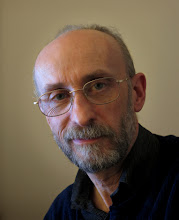About 25 years ago, I bought an old camera in an antique shop in Edinburgh. The owner was tinkering with it as I walked in, and I knew straight away it was mine! It was nothing flash, but the design intrigued me. It was made in an age when glass plates were still the standard medium for taking photographs. When I later sought an idea of the camera's age, it was suggested around 1870, predating the Eastman Kodak company by a decade or so. However, the design of the camera means that only dry plates would have been usable (it was designed to hold a stack of plates, so plates made with the wet collodion process would have been entirely unsuitable). Dry plates were in development during the 1870s, culminating in George Eastman's success in developing a machine process for mass-producing dry plates. So, I'd say this camera was built somewhat later than 1870.
 |
| Camera front; 1 cord for instantaneous exposure, 1 for time exposure |
 |
| Red cord is for cocking the shutter |
I have thought on several occasions that I should try to take a photograph with it, but the design made it a less than trivial task to do so, and I put it to the back of my mind until very recently. I have been tinkering with paper negatives for pinhole cameras, to get the development right for use as a negative, and with this foundation, it was an obvious step to using the old camera, using a small sheet of enlarging paper in a suitable cardboard holder.
 |
| Back end of camera |
 |
| Inside of camera back, showing mechanism for lifting next unexposed plate |
I had already established a nominal ISO speed rating for the paper, so with a hand-held light meter (a
Weston Master III, since you ask…), measurement of the f/ratio of the lens (about f/14 or f/28, depending on which of the 2 aperture stops is in use) and the 'B' or 'T' shutter setting, I was able to give a long enough exposure, as required. Shooting indoors, in a large antique shop, I decided on 45 seconds - manageable by the sitter I had 'engaged' for the job (the shop owner). The resulting negative was somewhat underexposed, as it turned out - possibly the light had changed after I took a reading, and before making the exposure - but with careful digital post processing after scanning the negative, I was able to get a good enough result. I'd like to compare it with any of the plates taken with the camera soon after it was made, but will have to be happy with this modern product.

Now, if I can make a rollfilm adaptor (taking 118 film, perhaps…), I might have something really usable.






5 comments:
That shoot looks amazing. I started my work life as a repro photographer and we also used HUGE cameras with very large film (for making offset printing plates). We also often had exposure times of 1+ minutes and more.
I always hated working with chemicals to develop these huge sheets of film ...
Hmmm... how huge? I'm trying to remember the name of the repro camera we had (possibly an Agfa). It took up to 20x16", if not 24x20", but we usually used no bigger than 5x4".
The main work was done with 14x14" glass plates, taken with a 48-inch aperture Schmidt camera, duping on to 3mm thick glass plates and film. The plates were developed manually, with the film going through a roller-transport machine. How I loathed that work. Quite enjoyed the process control though; wouldn't mind having a densitometer and plotting some characteristic curves, for old times' sake!
What I would love to develop again, is Cibachrome. That was such a gorgeous material, with the right original. Mind you, I loved the beauty and simplicity of the material and process just about as much as the results!
Here some links to give you an idea about their size:
http://www.kameramuseum.de/0-fotokameras/grossbild/zweiraum-regier/1home.html
http://www.camerapedia.org/wiki/Repro_camera
I don't miss these monsters. I prefer a good scanner and photoshop. That made life much more easy - and the results more predictable.
Sure developing your stuff in chemicals is a bit more magical and has more "randomess" to it - but I don't miss the smell, the endless preparations and unwieldy huge films.
;-)
Eskofot! That's the one. Almost portable, compared to those behemoths on Wiki.
Almost portable? Sure, when your name is Shrek. ;-)
Post a Comment